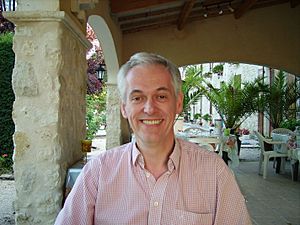Wim Crusio facts for kids
Quick facts for kids
Wim E. Crusio
|
|
|---|---|
| Wilhelmus Elisabeth Crusio | |

Wim Crusio, August 2006
|
|
| Born | 20 December 1954 |
| Citizenship | Dutch |
| Alma mater | Radboud University Nijmegen |
| Known for | Behavioral neurogenetics of the hippocampus, mouse models of neuropsychiatric disorders |
| Awards | IBANGS Distinguished Service Award |
| Scientific career | |
| Fields | behavioral and neural genetics, behavioral neuroscience |
| Institutions | Radboud University Nijmegen, University of Heidelberg, French National Centre for Scientific Research (CNRS; Paris, Orleans, and Talence (Bordeaux)), University of Massachusetts Medical School |
| Thesis | Olfaction and behavioral responses to novelty in mice: a quantitative-genetic analysis (1984) |
| Doctoral advisor | Hans van Abeelen |
| Other academic advisors | Bram van Overbeeke, Hendrik de Wit, Victor Westhoff |
| Author abbrev. (botany) | Crusio |
Wim E. Crusio, born Wilhelmus Elisabeth Crusio on December 20, 1954, is a Dutch scientist. He is a neurogeneticist who studies how genes affect behavior and the brain. He works as a research director for the French National Centre for Scientific Research in Talence, France.
Contents
Becoming a Scientist
Wim Crusio started his journey in science at Radboud University Nijmegen in the Netherlands. He earned his first degree in biology in 1975. After that, he continued his studies there, getting his master's degree in 1979. In 1984, he completed his PhD, which is the highest university degree.
Early Research
For his PhD, Dr. Crusio studied mice. He looked at how their genes influenced their behavior, especially how they explored new places. He used special methods to understand how these traits were passed down.
Working Around the World
After his PhD, Dr. Crusio worked as a researcher in different countries. From 1984 to 1987, he was at the University of Heidelberg in Germany. He then spent a year in Paris, France, in 1988. He returned to Heidelberg before joining the CNRS, a big French research center. He worked in Paris and later moved to Orléans. In 2000, he became a full professor at the University of Massachusetts Medical School in the United States. He returned to France in 2005. Today, he is an adjunct director at a neuroscience institute in Bordeaux.
What Dr. Crusio Studies
Dr. Crusio's research focuses on how genes affect the brain and behavior. He often uses mice to understand complex brain conditions.
The Brain's Learning Center
One area Dr. Crusio has studied is the hippocampus. This is a part of the brain that is very important for learning and memory. He and his team found that tiny connections in the mouse hippocampus, called mossy fibers, were linked to how well mice learned. They noticed that mice with larger mossy fiber connections often learned better, especially when finding their way around. Scientists are still learning more about this connection.
Understanding Depression
Dr. Crusio also uses mice to study conditions like depression. Scientists can create situations where mice show behaviors similar to those seen in humans with depression. His team looked at how stress affected mouse behavior and the growth of new brain cells. They found that stress changed how mice behaved and reduced new brain cell growth. However, these changes varied between different types of mice and between males and females. This research helps scientists understand the complex causes of depression.
Studying Autism
More recently, Dr. Crusio has explored if certain mice can help us understand autism. He looked at mice that are missing a specific gene called Fmr1. This gene is linked to Fragile X syndrome in humans, which often includes autistic symptoms. Dr. Crusio's review of studies showed that these mice do display behaviors similar to those seen in autism, especially changes in how they interact with others. This makes them useful for studying autism.
Sharing Knowledge
Dr. Crusio has played a big role in sharing scientific knowledge. He helped start a science journal called Genes, Brain and Behavior in 2001. He was its main editor for ten years. He also helped create rules for how studies on mice should be published. Since 2017, he has been the editor-in-chief of Behavioral and Brain Functions. He also helps edit other scientific journals, making sure that new research is shared correctly.
Helping the Scientific Community
In 1996, Dr. Crusio helped create the International Behavioural and Neural Genetics Society. This group brings together scientists who study genes, behavior, and the brain. He served in many roles for this society, including president. In 2011, he received an award for his great contributions to the field. He has also been part of other important scientific groups, helping to organize meetings and guide research.
Images for kids
See also
 In Spanish: Wim Crusio para niños
In Spanish: Wim Crusio para niños


